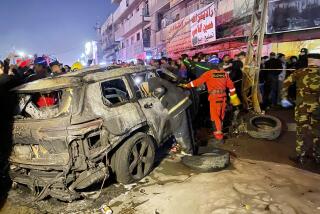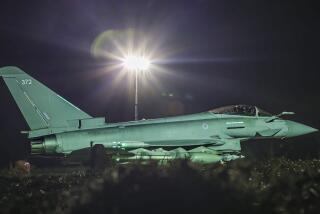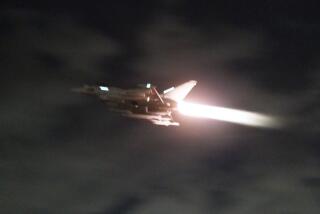U.S. investigating whether strikes against Islamic State killed civilians

For the first time in the months-long air campaign against Islamic State militants, American commanders have confirmed that they are investigating the possibility that civilians have been killed in U.S. attacks.
Until recently, Pentagon officials had insisted there were no credible reports that any of the more than 4,775 bombs and missiles that have been aimed at targets in Iraq and Syria had killed civilians. They credited painstaking planning and precision-guided weaponry for avoiding casualties to bystanders as they sought to obliterate tanks, artillery installations and supply lines used by the Islamist militants.
But U.S. Central Command, which oversees the campaign, has confirmed that it is investigating two December attacks — in Iraq and Syria — in which civilians may have been killed.
Military officials say that since the campaign against Islamic State began Aug. 8 they have examined the credibility of 18 allegations that coalition airstrikes resulted in civilian casualties.
Such charges come from a variety of sources, said Sgt. Sheryl Lawry, a spokeswoman for Central Command. Internal reviews, news reports, nongovernmental organizations and other U.S. government agencies, such as the State Department, all can yield reports.
Of the 18 reports — nine each from Iraq and Syria — 13 were found to be not credible. Three are still being assessed to determine their credibility, in addition to the two under investigation.
“It’s good that they’re finally showing a willingness to undertake rigorous investigations,” said Sarah Margon, director of Human Rights Watch’s Washington office. “But telling the public why cases aren’t being investigated is just as important. We aren’t seeing that quite yet.”
Activists have made widely varying estimates of how many civilians have been killed by U.S. bombs and missiles in the campaign against Islamic State.
“A lot of these strikes take place in small towns and on the outskirts of major cities,” said Sahr Muhammedally, senior program manager at the Center for Civilians in Conflict, a Washington-based human rights group. “It’s extremely challenging to get at the truth.”
For military officials trying to assess the claims, “the key to any allegation is whether sufficient verifiable information is available to make a determination,” Lawry said.
“A source is generally deemed to be credible if the source provides verifiable information, such as corroborating statements, photographs or documentation that can help us determine whether an allegation is founded.”
That statement points to a key difficulty of any assessment: Without a U.S. troop presence, the military has had difficulty gathering information either for targeting or evaluating battle damage.
The U.S.-led campaign against the militants, who have captured about a third of Syria and much of northern and western Iraq, is being planned by analysts hundreds, sometimes thousands, of miles away from the battlefield.
Because U.S. forces are not involved in ground combat, American commanders rely heavily on Iraqi security forces as surrogates for on-the-ground intelligence.
The U.S. has even less direct knowledge of action in Syria, where it does not have a similar partner. Information about the militants there comes primarily from airborne surveillance, intercepted communications and signals intelligence acquired by spy planes.
“The current environment on the ground in Iraq and Syria makes investigating these allegations extremely challenging,” Lawry said. “Traditional investigatory methods, such as interviewing witnesses and examining the site, are not typically available.”
Fadel Abdul Ghany, head of the Syrian Network for Human Rights, which tallies daily death tolls and other data of the Syrian conflict, said he was contacted by the State Department about reports of civilian deaths after U.S. airstrikes against Islamic State in Syria on Sept. 22.
The strikes, which also involved warplanes from five allied Sunni Arab nations, hit targets in and around the Syrian cities of Raqqah, Dair Alzour, Hasakah and Abu Kamal. The Pentagon said about 200 bombs were dropped, and 47 Tomahawk cruise missiles were fired from U.S. ships.
Ghany said he sent a report identifying civilians reported killed in Dair Alzour and elsewhere. But he said he could not provide photographs, video or other evidence because the towns are controlled by Islamic State fighters, who have slain troops and civilians from opposing camps, as well as Western journalists they have adbducted.
The State Department took the information and didn’t respond to Ghany about the analysis, he said. The department told The Times it doesn’t comment publicly on unconfirmed allegations of civilian casualties.
Haitham Rashid, head of the Iraqi government’s information and control center for Nineveh province, one of the northern areas that has seen heavy fighting, said the U.S. strikes have been “really accurate.”
But, he said, the attacks have resulted in five or six civilian casualties near Mosul, Iraq’s second-largest city.
“It should be said that the amount of casualties are very small because they’re very accurate,” Rashid said. “And also, no operation is without casualties.”
Special correspondent Nabih Bulos in Beirut contributed to this report.
More to Read
Start your day right
Sign up for Essential California for news, features and recommendations from the L.A. Times and beyond in your inbox six days a week.
You may occasionally receive promotional content from the Los Angeles Times.







